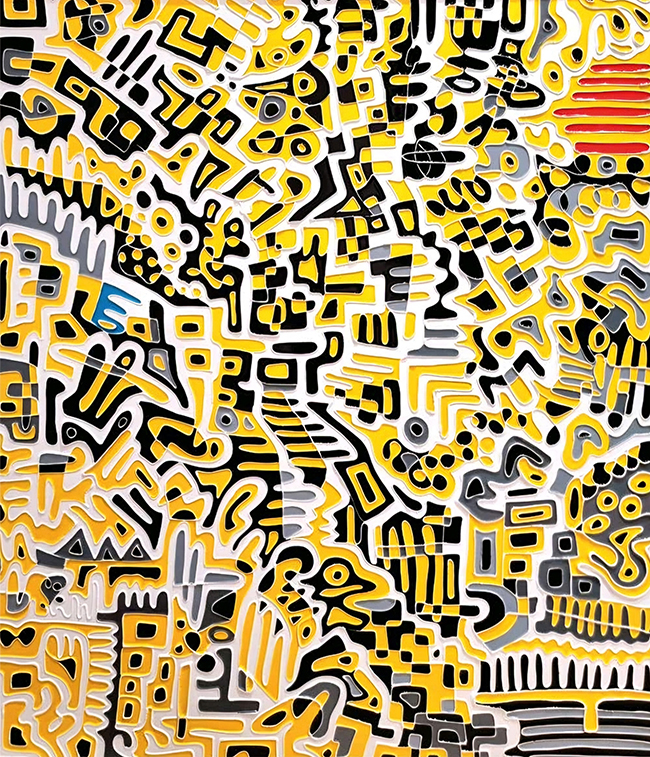Sabrina Puppin’s art unfolds like a complex story told through colors, shapes, and fluid patterns. Born in Aviano, Italy, and now based between Doha and New York, she is an artist whose work bridges the borders of realism and abstraction, offering viewers a way to see beyond the surface. Puppin’s approach is rooted in her belief that art can dematerialize the known world, revealing a complex web of relationships that lie beneath our everyday perceptions.
Puppin’s creative process is both spontaneous and deliberate. Her style is informed by an intuitive, almost playful, handling of paint, yet she’s also attuned to the way colors and forms interact with each other to create illusionistic space. This mix of intuition and structure sets the foundation for her compositions, which may appear at first as mosaics but quickly unveil themselves as something deeper. By mapping her own personal reality visually, she invites viewers to interpret and interact with the canvas in a way that feels personal and immersive.

In “Distorted Architecture Diptych,” she explores the energy of color and pattern in a way that’s both bold and captivating. With vibrant hues and intricate linear patterns, this piece radiates a kind of dynamism that’s hard to ignore. It’s an invitation for viewers to explore its details, drawing them into a sensory experience. The boldness of the colors isn’t just decorative—it carries an emotional charge, sparking excitement and a curiosity that feels alive and tactile. Puppin’s command over her medium becomes evident here, as she uses color not merely as a visual element but as a tool for evoking emotion and intrigue.
Her work “Islands” shifts the mood slightly, though it’s no less energetic. In this piece, Puppin layers vibrant colors and geometric patterns to create an artwork that feels both dense and harmonious. The piece has a rhythmic quality, with shapes that move and overlap in a lively dance across the canvas. Here, her work balances chaos with structure, offering a glimpse of order within the tumultuous array of shapes and lines. The repetitive patterns and varied forms create a kind of structured freedom, an organic geometry that feels both carefully planned and completely unrestrained. It’s a delicate balance, one that shows Puppin’s skill in crafting intricate visual narratives without overwhelming the viewer.

“New York’s Colors” is perhaps the most celebratory of the three pieces, capturing the city’s essence through a blend of form and color. The composition is a labyrinth of geometric patterns and shapes that mirror the energy and diversity of New York itself. Puppin’s use of contrasting colors and varying shapes makes each viewing of the piece a new experience, encouraging viewers to find fresh details with each glance. There’s an order within the chaos, a sense of cohesion that feels organic rather than forced. In this way, the piece mirrors the city’s own blend of structure and spontaneity, creating a visual experience that’s dynamic and immersive.
Through each of these works, Puppin draws from her surroundings and personal experiences, reshaping them into visual stories that feel both universal and uniquely hers. Her process is one of constant decision-making, from the lines she chooses to the colors she blends. Each stroke is a response to the one that came before, a chain reaction of choices that transforms the blank canvas into a vivid landscape of thought and feeling. This method allows her to explore themes of perception and reality, as each viewer is invited to bring their own interpretations to the piece.
In a way, Puppin’s work is about mapping spaces—both physical and emotional. Her loose, spontaneous approach allows her to capture fleeting moments and subtle shifts in perspective, using the medium itself to create layers of meaning. Her choice of color, her linework, and the way she allows her paint to interact with the canvas reveal her intent to dematerialize the familiar and invite viewers into a space where reality and abstraction meet. There’s an element of risk in her work, a willingness to let the process lead, to allow the materials to play a role in shaping the final piece.
Through her art, Puppin offers viewers a journey into an unseen world, one where colors and shapes act as guides. Her compositions encourage exploration, not only of the visual elements but of the emotions and thoughts they stir.
In Puppin’s world, art isn’t confined by form or perspective; it’s a fluid and ever-changing landscape, shaped by countless moments of decision and expression. Her work is a testament to the freedom of visual language, a reminder that colors and shapes can speak volumes without saying a word. With each piece, Puppin expands our understanding of reality and invites us to look beyond the surface, to see the world—and ourselves—in a new light.

